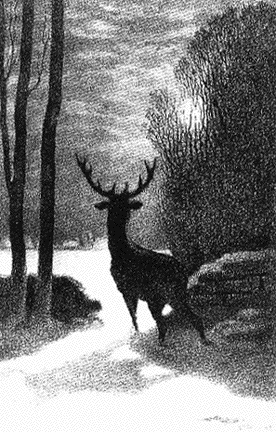|

"Deer in the Moonlight"
Lithograph 1859 by William Morris Hunt
Feeding Deer in Winter
by Russ Pascatore
(C) 1999 The Gobbler,reprinted from Thaw 1995
During the bitter cold winter, many Chautauqua
County folks start to feel sorry for the deer they see near
their homes and farms. During many years of heavy snow cover,
the deer are obviously starving. Kind hearted people would like
to help these animals. But unless done correctly, winter feeding
of deer can have great negative impact on them. You might think
you're helping the creatures when you are actually killing them.
The basic rule of wildlife is--if you love them, leave them
alone. But if you insist on feeding deer, it can be done correctly.
It takes considerable time, energy, and money. Buying a few
bales of hay to spread in areas during the middle of winter
for the deer to eat could be the nail in their coffins. Killing
them with kindness isn't what you want. A basic understanding
of deer biology is needed.
Whitetail deer are ruminants that have four-chambered
stomachs like cows. They don't have strong digestive juices
like humans, but rely instead on bacteria and one celled microorganisms
to break down the food matter they eat so it can be absorbed
into the body. In the winter the main organisms in their stomachs
are tuned to digest the whitetail's natural food of the season--primarily
buds, twig tips and other woody browse. Digesting hay, corn
or forage pellets requires different concentrations of stomach
organisms so that complete digestion can occur. It takes about
three weeks for a deer's stomach culture to change over to a
new type of food. During the transition the deer will eat the
food but gain very little nutrition from it.
If you are going to feed the deer hay, corn
or any food which is not part of their natural winter diet,
there are a few important rules to follow. Begin any winter
feeding program before deer become stressed by extreme winter
weather. This feeding program must continue until spring when
natural food is once again available. Several feeding sites
must be set up and replenished daily. A single site will only
benefit the dominant, larger deer. Whitetails don't share their
feed. The smaller, less dominant ones usually have less fat
reserves and need the feed more than the large deer. At a single
feeding site they are the last to eat, if there is any left.
It is much better to provide natural food in
the form of browse. Take out the chainsaw and knock down some
red maple, striped maple, dogwood, apple, or witch hazel to
provide food that can be digested immediately. In winter, starving
deer are sometimes drawn by the sound of a chainsaw, and will
feed on downed tree tops as soon as they are cut. Also, the
sprouting stumps will provide food for years to come. Timber
stand improvement and other logging activities during winter
months actually help deer more than other feeding efforts.
Before starting an artificial winter whitetail
feeding effort, much consideration and a a strong commitment
of time and money must be made. It is best to enjoy nature as
is or help it out with constructive activities which increase
the natural browse available. Enjoy the deer this winter!
|